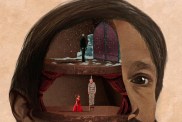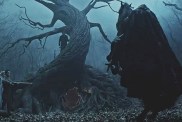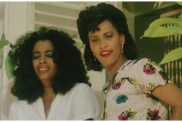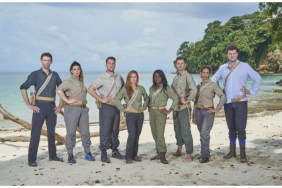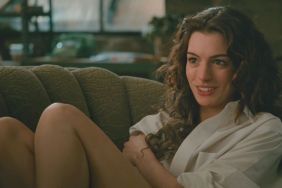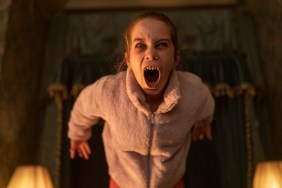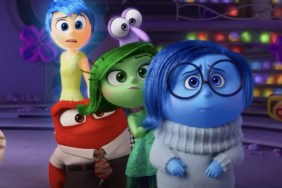Laid to Rest helmer talks web series

Rob Hall has built up quite a pedigree for himself in the horror genre over the course of the last few years.
Besides fronting Almost Human FX, the company he formed back in 1996 which has gone on to provide the special effects for The Crazies, Quarantine, The Burrowers and Terminator: The Sarah Conner Chronicles, he made his directorial debut in 2004 with the impressive drama Lightning Bug. He followed that up with this year’s straight up “slasher” flick Laid To Rest and introduced horror audiences to Chromeskull.
Now, he’s assembled a who’s who list of recognizable genre faces including Robert Englund, Kane Hodder, Danielle Harris and Lisa Wilcox for Fear Clinic, a new web exclusive series for FearNET. We recently caught up with him to get the full scoop on the making of Fear Clinic, which will make its Internet debut later this month. Read on!
Shock Till You Drop’s Robg.: How did you get involved with Fear Clinic? Did you already have a relationship with FearNET when you jumped on board to this project?
Rob Hall: I didn’t really have a relationship with FearNET, but I did have a relationship with Robert Englund and Mark Johnson, one of his producers on his movie, Killer Pad. I knew both of them and we had worked together on Robert’s movie and I stayed in touch with Mark. He had talked about this project – There was a feature script called Heebie Jeebies that they originally sent me and wanted me to direct, but the timing just didn’t work out, and the script needed just a little bit of work before we did it as a feature. Mark had known someone at FearNET who made the introduction and he originally presented it as “What would you think about a web series with Robert Englund?” And I think that script that Aaron Drane had written was retooled to be more episodic and then it came back to me. Robert Englund drove up and him, Mark, myself and Aaron had a meeting with FearNET for the first time in January of 2009. I didn’t really know them too well, I knew them by proxy. When Almost Human FX was doing The Burrowers, JT Petty was working on the FearNET short Blood Red Earth. So I knew a little bit about how they operated, but I wasn’t really sure how it’d work. All I knew is that Englund was really excited about doing this. We met with them and Robert was just so gung-ho about Fear Clinic that I think we basically sold it to them in the room. When they walked in to see the shop, they knew I was not messing around when it came to this stuff and they knew Englund was excited about it. The script was good. It took about 6 months to get all the logistics worked out, but once we did, I was already on the set of The Crazies and I got the message they wanted me to do it. Originally I was going to direct half of them, there was another DP that was going to be on it originally, but then he got another job or something, so they asked me to do all 5 episodes.

Robg.: Once you got hired as the director, how much influence did you and Robert Englund have, especially that it was now a feature being broken up into 5 segments? Did you get to collaborate more with writer Aaron Drane?
Rob Hall: Yeah, we had a lot of influence. I did a sort of director’s polish on all 5 episodes. Aaron was really cool and open to that. For me, it was part of the process. I’ve never directed anything I haven’t written. So the scripts were good, but I thought there were a lot of things, just blocking-wise that you need to get in your mind so you can set it up before shooting. I thought it was missing a few cool creepy moments that I thought the shop could bring to it. And it’s easier to just write it then to try to explain. So I did do a polish on it with Aaron and we’d send it back and forth. It was a really cool collaboration and it helped, because I’d never directed something I hadn’t written, so I was glad I got to put my own voice on it.
Robg.: In Fear Clinic, the basic premise involves a doctor (played by Robert Englund) who helps people conquer their fears by facing them. That’s a universal idea, the idea of facing your fears. Was that one of the things that stood out for you about this?
Rob Hall: I know that’s one of the things that made Englund very excited. Yeah, there’s obviously something very simple about the idea that’s appealing to me. Everybody’s scared of something and the fact that there’s thousands of classified phobias and most of them have something to do with something cool and disgusting that the shop could make was exciting. For me, other then the deep subtextual meaning of everything, it was just exciting to have a project with Englund and other guys I knew I could get and have something we could make really cool. I set out to make the tone of it more of a fun anthology, like the Tales from the Darkside and all the stuff that I loved. Living in Alabama, I’d come home on a Friday night and no one could talk to me that night because at 7pm Monsters came on and then Tales From The Darkside came on at 8 and then Freddy’s Nightmares and then Friday The 13th: The Series. There were like 6 shows back to back then and that was my Friday night. Looking back some of that stuff doesn’t hold up! But you can’t tell that to a fledgling FX artist at the time, I was just so excited that there were shows like that. There’s not really anything like that on television anymore. Masters of Horror was the closest thing in a long time, but I thought personally that show missed some good, obvious opportunities. I thought this would help fill a much needed void right now. Englund and I were watching a scene and we were both sitting by the monitor and saying, “There is nothing like this on TV anymore. It’d be so cool as a real show.” So we approached it like we were making a movie or a decent budgeted television series. We pulled a lot of favors and a lot of people into it and we never really thought about it as something for the web. We just thought lets make this as good as it possibly can be.

Robg.: You’ve got Robert Englund and Kane Hodder and Danielle Harris â pretty much a who’s who list of genre actors. We’re about the same age, so these are people whose films we both grew up on! To be a fan of these people and then get the chance to work with them, what was that like for you?
Rob Hall: Geekdom! I’m not going to lie! Just having Englund in something, period. I got to work with Robert in a Roger Corman movie I did in 96, putting make-up on him. That was one of the coolest things ever for me, just meeting him and gluing something to his face knowing he’s my idol. I mean, Freddy Krueger is my idol. That was also my favorite franchise growing up. That’s so trippy just to do something like that and then several years later when I got re-introduced to him, I got to help on his movie. He’ll probably admit to this, but he’d turn to me during Killer Pad and say “Robert, I haven’t directed a movie in a while and you have so what do you think?” Helping Robert set up shots on his flick, that was a kick. Then when this came around, completely topsy turvy and now I’m directing him, it’s complete geekdom. You start from there and I’ve been so fortunate to be friends with these people. Kane Hodder, I’ve worked with before. Kane was cast by me making a cell phone call late one night. It was just “Want to be on this show?” And he was like “Yep” and that was that. That was so cool. Once we were able to go around and say we had both Kane and Robert in this, we’ve got this great duo and people recognized we were trying to do something fun. FearNET just wanted some good actors in it, but I thought let me fill this in as a fan and with people fans would want to see together. I knew there was a stigma associated with doing a web series. I’d watch a lot of the ones I could find on-line, Angel of Death probably one of the few with really good production values. There is a stigma when you call people and ask them to be part of a web series, they feel like it’s not a real project. But I thought let’s try to blow that out of the water and get people really interested in it. I have to attribute Englund, having him so believe in this project from the get-go made it easier to cast. Kane and Danielle were excited to do it. Danielle I hadn’t worked with before, but she just immediately came to mind. I thought OK, we’ve got Friday the 13th and Nightmare on Elm Street covered. Who could we get from Halloween? It was something I wanted to do as a fan as that extra added bonus by putting these people together for the show.
Robg.: I’ve seen a few clips from the show already and it seems like you balance a really good mixture of both practical and digital FX. Being that you’re handling both aspects, I assume you’re shooting with both methods in mind?
Rob Hall: Absolutely. In terms of the FX, it’s all literally about preparation. A lot of the backlash people have against CGI FX is warranted, because a lot of it is a manifestation of lazy filmmaking. Like, “We’ll fix that later! We’ll put the monster in later.” I’ve never really liked that stuff. As a result, you get so much footage and you don’t have a lot of money so it ends up looking like a Sega video game. I think that now you’ve got a lot of these great filmmakers out there like JT Petty who have a great aversion to it and want to do it practically. I’m the same way too, I want to do it as practically as possible. Not just because I own a shop, but because I feel it helps people on set when they have something to interact with. I’m also not one of those FX artists that says, âRubber monsters all the way!â I’m cool with any tool that helps me tell the story, and I personally think that FX work the best when you can’t tell which part of it is digital and which part is practical. I’ve always wanted to do that and with Laid To Rest, we started setting up a digital side to Almost Human with Almost Human Digital. We did about 80 percent of the FX in house. It was so freeing to have that. I planned it a certain way and I shot it a certain way, but if I wanted to tweak something here, we’d take it to the next room in After Effects and do it. And if I needed an element of something, say blood running down, we’d go back in the shop and shoot it, come back, import it and fix it.

So I realized, I took that old boss mentality of the 80’s where they had an FX side and a creature side and it doesn’t really exist much anymore. Digital video where it’s gone now, we could do that on a much smaller scale and pretty cost effectively to have it all under one room. Laid to Rest gave me a lot of confidence in being able to know what we could achieve practically. So the long winded answer to that is yes, it’s all about preparation. Inadvertently, you’ll have some stuff you need to fix but for the most part everything worked the way it was supposed to. It’s easy for me to look at an effect or even read it on the page and think this would be better to do with rubber feet and then pick it up with digital, augment it there. Or we could do this with rods and then just take the rods out digitally later. It’s pretty easy for me to do that here and I also have a great team, so I can spitball stuff with them. Yeah, everything worked out the way it was supposed to.
Robg.: I think it’s great when a filmmaker strikes the perfect balance for it. For example, Lena Heady’s death sequence in Laid to Rest where it’s partially her and partially not, that was a great marriage of practical and digital.
Rob Hall: I think it only helps you. I have the fortunate position of being the director who gets to call the shot and figure out how to do it, but I also have over 16 years of experience with FX, so I know instantly how I’m going to screw something up if I’m not careful. There are just so many variables. When you’re on someone else’s movie, so many variables get in the way. You have a great plan, you explain how to shoot it, we can do this you say, you’ll never see this side and it’ll sell this effect, and then something will come up. They’ll change their mind. They’ll want to do it from over this angle. Or they’ll need to put a blue gel over something. Whatever it is, you have to adapt. Not that I think FX are the most important thing, but I definitely put those at the top of the list in terms of execution. Even if I have to move the structure of the whole scene to make the effect we played for the day work, that’s what I’ll do to make sure we deliver on that stuff.
Robg.: It’s a horror movie! That’s the payoff! [Laughs]
Rob Hall: Yeah, I think it’s the payoff! And I’ve tried to tell producers that for 16 years! But they don’t ever want to believe that. [Laughs] So, with my projects I try to do that and hopefully people respond to it. I do still think FX are just there to serve the characters and the story, but you’ve got to deliver on them and have fun with it. I think we did that for Fear Clinic for sure.

Robg.: You shot your first feature Lightning Bug on film, but then Laid To Rest and now Fear Clinic digitally. Can you tell us about using each medium from film to film?
Rob Hall: I like experimenting with different mediums, I really do. Laid to Rest was about a digital killer, essentially. So I was cool with shooting that digitally, I wanted to. After Laid To Rest and Fear Clinic, I’ve gotten really dependant on having that instant gratification of being able to offload stuff on their memory stick and then someone with my laptop could be in the next room cutting it. And then I get to look at it an hour later. I’m pretty addicted to that now! My next movie is going to be shot on 35, I’m trying to figure out a way to have a similar set up because I’m so addicted to instant editing, its such a great tool. I love film, it’s got a great organic quality to it. I think Lightning Bug benefits from being shot on film. I think my next movie Old Scratch will benefit also it has that analogue feel from being shot on film. But I’m not averse to shooting on whatever you can use. I think there are some great digital cameras now. We shot Fear Clinic on the Sony EX3 and it looks fantastic.
Robg.: You guys shot Fear Clinic at Linda Vista Hospital, which is of course the famous shooting spot for the boiler room in the original Nightmare on Elm Street. Was it a conscious choice to shoot there? Or just convenience?
Rob Hall: To be honest, Linda Vista is just the go-to low budget place to shoot in LA. If you need something hospital like, you shoot there. It was funny, I was looking at Angel of Death not too long ago and they shot there too! It’s got great production value. Every single one of us have worked there before. Englund obviously, Danielle Harris, too. And Kane Hodder, the last time I worked with him was on a movie called Room 6 and I was at Linda Vista doing prosthetics on him. It was just one of those places we’d all shot at. It wound up being great and they were really awesome to us there. I think we made it look pretty good.
For more on Hall’s next project Old Scratch, as well as the Laid to Rest sequels, check our previous post here. Fear Clinic airs exclusively on FearNET October 26th!





Source: RobG.
